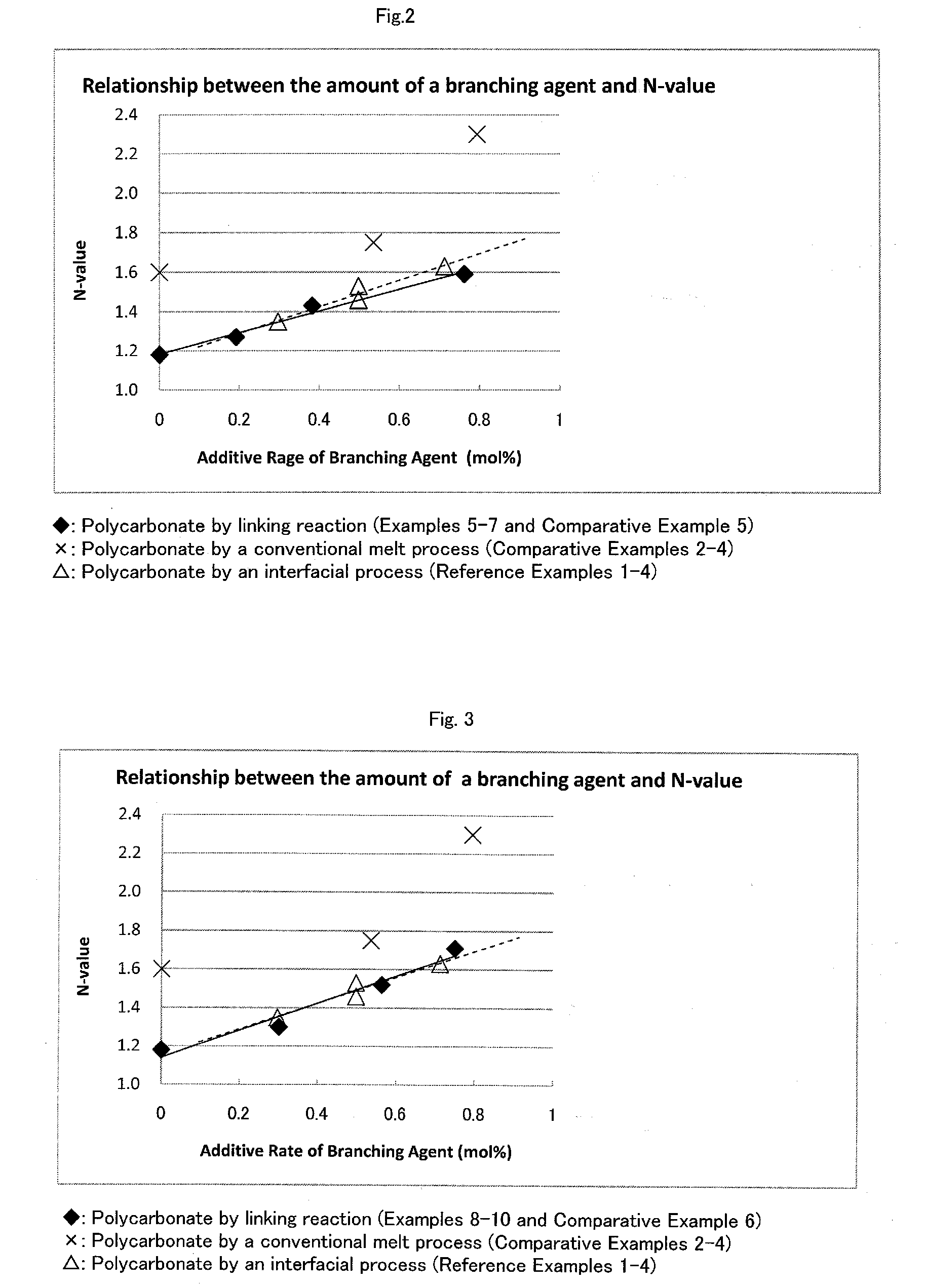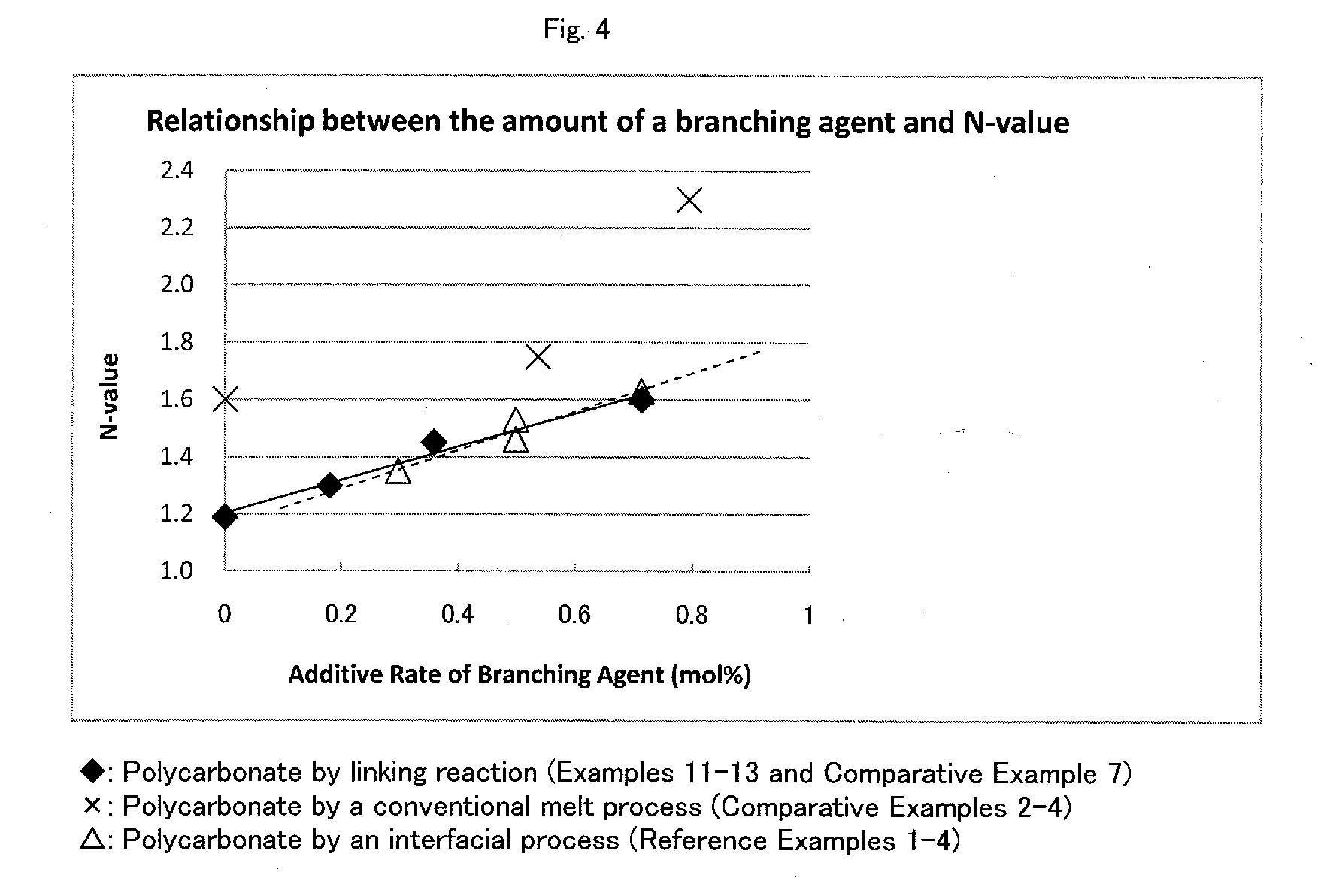Process for manufacturing branched aromatic polycarbonate resin with desired degree of branching
a technology of aromatic polycarbonate resin and manufacturing process, which is applied in the field of manufacturing process for branched aromatic polycarbonate resin with a desired degree of branching, can solve the problems of difficult to control the amount of branched structure, toxic phosgene must be used in the manufacturing method, and the difficulty of molding large-scale products, etc., to achieve short reaction time, reduce the effect of temperature and high reaction ra
- Summary
- Abstract
- Description
- Claims
- Application Information
AI Technical Summary
Benefits of technology
Problems solved by technology
Method used
Image
Examples
reference examples 1-4
and
[0073]FIG. 2 shows a graph showing the relationship between the amount of the branching agent used and N-value of the polycarbonates obtained by Examples 5-7 and Comparative Example 5.
[0074]FIG. 3 shows a graph showing the relationship between the amount of the branching agent used and N-value of the polycarbonates obtained by Examples 8-10 and Comparative Example 6.
[0075]FIG. 4 shows a graph showing the relationship between the amount of the branching agent used and N-value of the polycarbonates obtained by Examples 11-13 and Comparative Example 7.
MODES FOR CARRYING OUT THE INVENTION
[0076]The process of the present invention comprises a step of carrying out highly-polymerizing reaction between an aromatic polycarbonate prepolymer having a branched structure introduced by using a predetermined amount of a branching agent and an aliphatic diol compound in the presence of a transesterification catalyst under reduced pressure.
(1) Aromatic Polycarbonate Prepolymer
[0077]The aromatic ...
example 1
[0253]45.5 g (0.20 mol) of 2,2-bis(4-hydroxyphenyl)propane (hereinafter, “BPA”), 46.0 g (0.21 mol) of diphenyl carbonate, 0.15 g (0.49 mmol) of 1,1,1-trisphenolethane (hereinafter, “TPE”) and 1 μmol / mol of sodium hydrogen carbonate as a catalyst, wherein “1 μmol / mol” means 1 μmol per mole of the total amount of BPA and TPE, were charged into a 300 cc four-neck flask equipped with a stirrer and a distiller and was heated at 180° C. in an nitrogen atmosphere with stirring for 30 minutes.
[0254]Subsequently, the degree of pressure reduction was adjusted to 20 kPaA (150 torr) and simultaneously the temperature was raised to 200° C. at a rate of 60° C. / hr and the transesterification reaction was carried out for 40 minutes keeping the temperature as it is.
[0255]Then, the temperature was raised to 225° C. at a rate of 75° C. / hr and the temperature was kept as it is for 10 minutes.
[0256]Subsequently, the temperature was raised to 260° C. at a rate of 65° C. / hr and the pressure was reduced to...
example 2
[0260]45.5 g (0.20 mol) of 2,2-bis(4-hydroxyphenyl)propane, 46.0 g (0.21 mol) of diphenyl carbonate, 0.30 g (0.96 mmol) of 1,1,1-trisphenolethane (hereinafter, “TPE”) and 1 μmol / mol of sodium hydrogen carbonate as a catalyst, wherein “1 μmol / mol” means 1 μmol per mole of the total amount of BPA and TPE, were charged into a 300 cc four-neck flask equipped with a stirrer and a distiller and was heated at 180° C. in an nitrogen atmosphere with stirring for 30 minutes.
[0261]Subsequently, the degree of pressure reduction was adjusted to 20 kPaA (150 torr) and simultaneously the temperature was raised to 200° C. at a rate of 60° C. / hr and the transesterification reaction was carried out for 40 minutes keeping the temperature as it is.
[0262]Then, the temperature was raised to 225° C. at a rate of 75° C. / hr and the temperature was kept as it is for 10 minutes.
[0263]Subsequently, the temperature was raised to 260° C. at a rate of 65° C. / hr and the pressure was reduced to 0.13 kPaA (1 torr) o...
PUM
| Property | Measurement | Unit |
|---|---|---|
| boiling point | aaaaa | aaaaa |
| temperature | aaaaa | aaaaa |
| pressure | aaaaa | aaaaa |
Abstract
Description
Claims
Application Information
 Login to View More
Login to View More - R&D
- Intellectual Property
- Life Sciences
- Materials
- Tech Scout
- Unparalleled Data Quality
- Higher Quality Content
- 60% Fewer Hallucinations
Browse by: Latest US Patents, China's latest patents, Technical Efficacy Thesaurus, Application Domain, Technology Topic, Popular Technical Reports.
© 2025 PatSnap. All rights reserved.Legal|Privacy policy|Modern Slavery Act Transparency Statement|Sitemap|About US| Contact US: help@patsnap.com



